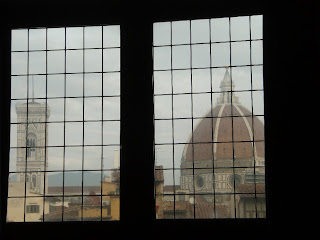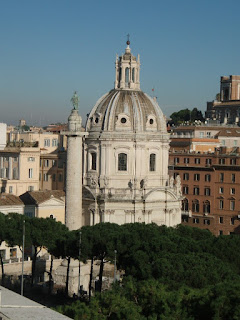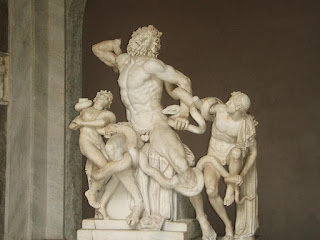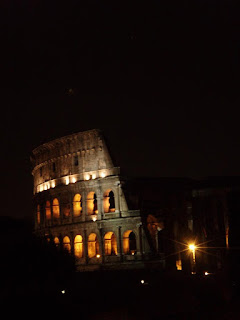A French reggae group this time, Tryo, grabbed my attention with their new song Ce qu'on seme. They already had good old hits like L'hymne de nos campagne or France Telecom, this one is just one more good music bite.
Tuesday, December 23, 2008
Friday, December 19, 2008
Firenze the Artsy

Florence in a day is a marathon task, even in winter and without crowds in the museums! I started at 8 am and was running until 7 pm non stop, with just time for a coffee and an ice cream, and still, there are things i wish i had time to see (like the Medici mausoleum, Santa Trinita church etc.)!



- Brancacci capella decorated by Masacio between 1425-1428, the inspiration to the Renaissance to come. As Da Vinci said, the first real painters were Masacio and Giotto. Unfortunately Masacio died at only 27, Brancacci capel being his masterpiece to the world. His Adam and Eve expelled from paradise can be seen as inspiration for Rennaissance - or even Munch, closer to us:

- Gioto's cross at Sta Maria Novella

Otherwise, more down to earth, Florence boasts numerous nice places for hot chocolate and sandwiches - for instance Ino' near Uffizi, and very good ice cream joints for any taste.


The list of my favorites is long, and please don't forget i only had a day to spend there, running literally from one place to another...:
- San Marco monestary with cells painted by Fra Angelico (Beato Angelico), in the style of the Annonciation below that greated monks as they went to their dormitories. Not only Cosimo the Elder of Medici family had his private cells in this monestary, but also the christian fundamentalist Savonarolla lived and ruled from there, until he was burnt by the same city that followed his advice and burnt its books just a few years earlier...(see last novel by Salman Rushdie, the Enchantress of Florence for more historic details and interesting interpretations)

- Bargello and the newly restored David, the second David in Florence, by Donatello this time, along with Jean the Baptist and the most impressive of them all, the wooden Magdalena statue at the Duomo Opera not to miss:

- Brancacci capella decorated by Masacio between 1425-1428, the inspiration to the Renaissance to come. As Da Vinci said, the first real painters were Masacio and Giotto. Unfortunately Masacio died at only 27, Brancacci capel being his masterpiece to the world. His Adam and Eve expelled from paradise can be seen as inspiration for Rennaissance - or even Munch, closer to us:

- Gioto's cross at Sta Maria Novella
- Uffizi and its Boticelli, who with Michel Angelo later and many others was welcomed by the Medici family, ate at their table, and painted their portraits.
- Palatine Gallery housed in the Pitti Palace, originally planned by the Pitti family who went bankrupt during the construction process. Eleonore de Toledo, married to the Medici, bought the palace for the rival Medici family and transformed it into the royal habitat where the last Medici died in the 18th century, bequesting all the art works to Florence. Thank you, Anna Maria Louisa for this priceless gift! My favorite in the museum was the below heavenly Madonna by Rafael:

Otherwise, more down to earth, Florence boasts numerous nice places for hot chocolate and sandwiches - for instance Ino' near Uffizi, and very good ice cream joints for any taste.

Wednesday, December 17, 2008
Rome Galleries

Rome is, without a doubt, a very rich city in art, especially its various galleries and Palazzios. My favorite ones from what i had time to explore follow:
If you have time for only one, definitely go to the Borgese Gallery. It is situated in a calm and romantic garden, and preserves incredible works, especially several statues by Bernini, the inventor of Barocco, and the third genious Italian sculptor in the direct Donatello-Michelangelo line.
One has to see Daphne and Apollo to believe it. It captures the moment when Daphne is transforming into a tree while still being chased by lustful Apollo, the picture hardly represents the life-like, pure emotion syrup:

And this view of David in motion:
 Another rich Palazzo-museum is the Capitolian one, situated on Michelangelo's Campodoglia, the perfect plazza. It is full of Roman and Greek statues from various excavations, and is itself situated where the old Jupiter temple used to stand on the Capitolian hill, the center of Roman civillization. The museum also beholds the bronze statue of the wolverine that supposedly fed Romulus and his brother Remus in their infancy, before they founded the eternal city.
Another rich Palazzo-museum is the Capitolian one, situated on Michelangelo's Campodoglia, the perfect plazza. It is full of Roman and Greek statues from various excavations, and is itself situated where the old Jupiter temple used to stand on the Capitolian hill, the center of Roman civillization. The museum also beholds the bronze statue of the wolverine that supposedly fed Romulus and his brother Remus in their infancy, before they founded the eternal city.
Another interesting visit has been to the Medici Villa and its gardens. They are only accessible on specific times as it is still the residence of the young French Rome prize winners for art. The villa is situated on another hill, close to the Plaza de Spagna, with very beautiful views of the Rome panorama, but also incredible gardens:

It is easier to understand seeing these gardens how painting would start incorporating perspective into its quarters. Numerous French artists lived in the villa, such as Debussy or Berlioz, Ingres was its director for years, Velasques painted the below arch in his paintings several times. All of these references, and a knowledgeable guide speaking both, Italian and French, make the garden visit a must for the art-inclined.

Bellini expo at the Scuderie de Quirinale is worth a glimpse - it highlights the artist's journey from Messina's influence to the final mastery, as with this Christ with the cross from the Isabella Gardner Museum:
I also enjoyed Barberini Palace and its Carravagios as well as the Colonna gallery (only open on Saturday mornings), still reserving its very beautiful decoration and marble floors for the curious souls. Less impresive, although possible visits are the Spada, Corsini, and Venezzia Palazzos, all full of further works of art.
I did forget about the ancient Rome here, but there were just too many museums to see...to pay tribute to the Romans, here we go:

Oh, and Merry Christmas to everyone:

Tuesday, December 16, 2008
Vatican
 Today I have spent the day in the Vatican, the other of the three countries represented in Rome (Maltese order apparently has the third official country in Rome since they have been thrown out of the Malta island in the 19th century and kindly welcomed by the Pope in Rome).
Today I have spent the day in the Vatican, the other of the three countries represented in Rome (Maltese order apparently has the third official country in Rome since they have been thrown out of the Malta island in the 19th century and kindly welcomed by the Pope in Rome).It is definitely a very impressive place, especially the San Pietro Basilic and its incredible size. It is difficult to comprehend, given that a small plane can fly inside the 100m dome, or that the baldanchin below by Bernini is 30m high. As a side note, the bronze to make this baldachin comes from the roof of the Pantheon. As the romans say - what the Barbarians did not manage to distroy, the Barberini did (the family of the Pope who dared):
 The Swiss guard is still guarding the Pope:
The Swiss guard is still guarding the Pope: But the jewel of it all is the treasure of the Vatican museum, or museums as there are 14 of them. Not as big as Louvre, it took me all 6 hours to make a complete tour - and several rooms were closed for that. Below is the statue of Laocoon, a good start to understant a little bit better the forms Michel Angelo painted in the Sixtine:
But the jewel of it all is the treasure of the Vatican museum, or museums as there are 14 of them. Not as big as Louvre, it took me all 6 hours to make a complete tour - and several rooms were closed for that. Below is the statue of Laocoon, a good start to understant a little bit better the forms Michel Angelo painted in the Sixtine:
And here is Michel Angelo, as depicted by his rival, Rafael, on his incredible stanza of Athene School. While Rafael was working on the rooms of the palace, Michel Angelo was painting the Sixtine Chapel - both started the same year!

It is said that Michel Angelo did not allow anyone to see his work except for the Pope. Rafael stole a glimpse and was so impressed that he had to change his own style to introduce Michel"s muscular ways (i.e. the knees of this Michel Angelo...). Notice the girl in the left corner - she and Rafael himself are the only ones in this picture looking directly at the visitor. An apparition, similar to Rembrand"s angel in the Ronda painting.
And not to forget the master, here is a detail from the Sixtine Chapel"s roof, the God father himself, in the process of creating the Sun and the Moon:

Nothing, no other Pieta, can meet the standards sat up by this work of a 23-year old, unspoilt like his marble, Michel Angelo entering the world of Art:

Rome, the First Sight

My first encounter with Rome has been rainy and rather sad - as the above picture of Mary Maggiore Basilic, one of the four dedicated to the Virgin and worth a visit.
It took me some time to start appreciating the views - it all began here, in the cloister of Giovanni the Laterano cathedral, reminding me of Barcelona, Toledo, and the mystery of faith - of which Rome is definitely full of:

This is the inside of the cathedral, where only the Pope can celebrate in front of the altar beneath the baldachin - they love baldachins here (the four-pillared thing in the middle, yes, i did not know what a baldachin meant in a church either...)

Laterano cathedral is impressive - especially if visited before San Pedro. The most stunning for me ware these Saint Stairs: the legend says it was Constantin"s mother who brought the marble stairs, now covered with wood for preservation, from Jerusalem. It is the most impressive relique I have seen so far! They were originally the stairs of Pilate"s palace on which Jesus walked to be judged...Now they are walked on knees only by the piligrims...

Here is the last site - to finally fall in love, despite the rain and the cold with the Eternal one:

Monday, December 08, 2008
Veloso, Canteca de Macao and Macaco
Continuing on the Spanish-language music trend i am keen on exploring lately, below is the incredible Tonada de luna llena from Veloso i first heard in ¨Flor de mi secreto¨ by Almodavar:
And more from Canteca de Macao in a different vein, but also interesting and very very spanish...
And a third one, Macaco, an international mix from Barna, still another genre...
And more from Canteca de Macao in a different vein, but also interesting and very very spanish...
And a third one, Macaco, an international mix from Barna, still another genre...
Vilanova y Cubells

This cold winter w-end we decided to sample Vilanova. I have never yet been to this crag, thus we aimed at Nicromancer, an easy 4-pitch route. Finally we ended on a different neighbor in cold winter wind, which made us quickly decide for sport climbing nearby in more clement conditions.
The second day we went to a sport crag, Cubells, with incredible light, good climbs and almost shirt-less climbing. Below myself on a nice 6b (pic by Cathy):

And Cathy, sampe place, really great pic:

Subscribe to:
Comments (Atom)

